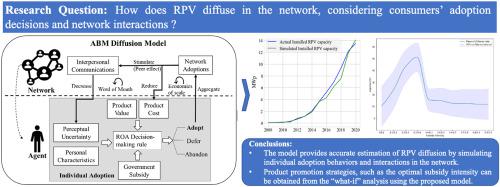Journal of Cleaner Production ( IF 9.7 ) Pub Date : 2022-06-23 , DOI: 10.1016/j.jclepro.2022.132793 Nan Zhang , Yujie Lu , Jiayu Chen , Bon-Gang Hwang

|
Residential Photovoltaic (RPV) is designed for residential buildings to generate electricity from solar energy. Despite various government regulations to boost PV deployment, RPV diffusion in Singapore has been slow, accounting for less than 4% of installed PV capacity by 2021. Investment volatility and uncertainty impede RPV deployment as it significantly affects consumers' adoption decisions. RPV diffusion analysis helps researchers develop deployment strategies by considering and modelling the RPV diffusion process and its major influencing factors. However, the existing works neglect heterogenous consumers' behaviours to address investment volatility in the network. Consumer behaviours, including spontaneous adoption decisions and interpersonal communications, are essential in determining RPV adoption and diffusion. This study constructed a Real Options Analysis supported Agent-Based Diffusion Model (ROA-ABDM) to investigate the RPV diffusion in Singapore by applying the “bottom-up” simulation modelling approach. ROA is used in simulation based RPV diffusion analysis to offer consumers flexible options to address investment volatility by calculating the option's value. Afterward, the Agent-based diffusion model is developed, calibrated, and validated with RPV historical diffusion data in Singapore. From the “what-if” analysis using the developed model, this study identifies that the optimal RPV subsidy intensity is 30–40% and reveals that RPV diffusion is more effective in a tight-knit network and sensitive to investment volatility. Based on the findings, this study proposes two policy suggestions, including stage-based dynamic policy and trusted-network oriented campaigns. This study contributes to the body of knowledge by integrating ROA analysis into agent-based modelling for the RPV diffusion analysis, and the proposed model can be extended to analyse other renewable energy technologies in different geographic regions.
中文翻译:

新加坡住宅光伏部署的基于代理的扩散模型:消费者行为的视角
住宅光伏 (RPV) 专为住宅建筑设计,以利用太阳能发电。尽管政府出台了各种促进光伏部署的法规,但新加坡的 RPV 普及缓慢,到 2021 年占光伏装机容量的不到 4%。投资波动和不确定性阻碍了 RPV 的部署,因为它显着影响了消费者的采用决策。RPV 扩散分析通过考虑和建模 RPV 来帮助研究人员制定部署策略扩散过程及其主要影响因素。然而,现有的作品忽略了异质消费者的行为来解决网络中的投资波动。消费者行为,包括自发的采用决定和人际沟通,对于决定 RPV 的采用和传播至关重要。本研究构建了一个实物期权分析支持的基于代理的扩散模型(ROA-ABDM) 通过应用“自下而上”的模拟建模方法来研究新加坡的 RPV 扩散。ROA 用于基于模拟的 RPV 扩散分析,为消费者提供灵活的选择,通过计算期权的价值来应对投资波动。之后,使用新加坡的 RPV 历史扩散数据开发、校准和验证基于代理的扩散模型。从使用开发模型的“假设”分析中,本研究确定最佳 RPV 补贴强度为 30-40%,并揭示 RPV 扩散在紧密网络中更有效,并且对投资波动敏感。基于研究结果,本研究提出了两个政策建议,包括基于阶段的动态政策以及面向可信网络的活动。本研究通过将 ROA 分析集成到基于代理的 RPV 扩散分析建模中,为知识体系做出了贡献,并且所提出的模型可以扩展到分析不同地理区域的其他可再生能源技术。










































 京公网安备 11010802027423号
京公网安备 11010802027423号